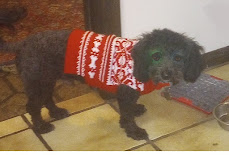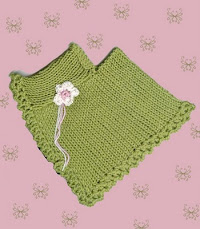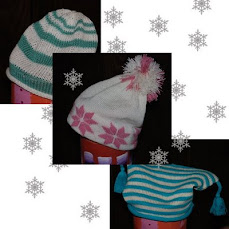It's especially sweet in that pale yellow color. Sandy hand pulled her needles to make the ruffles, a really labor intensive prospect. Sandy's pattern was published years ago in Knitwords----can't remember which issue right now. Whomever received that blanket should know what a labor of love that was!!!
Since the theme for the contest this year at Purls of Joy (April, Princeton, MN) is "ruffles", I thought I'd post a little about a more automatic method of making ruffles. You can try this method for doing ruffles on the machine that takes about 1/4 the time as hand pulling needles.
These directions are for Brother electronic machines and use the part buttons to have the machine not knit the short side of the ruffle. You could adapt it for a punchcard machine and if you speak different machine languages, you could probably convert it to a different machine.
The pattern is 24 st x 26 rows. Copy
the ruffle pattern and use whatever means you use to get the pattern
to your machine (DAK, PPD, inputting the pattern by hand, etc.)
The horizontal stitches knit and the vertical ones don't.
Position the pattern at L7 to R 7. Cast on with waste yarn and K a few R
over N L7 to R7 at desired tension.
E
wrap cast on over these N left to right with MC right over the waste yarn and K 3 R.
CAL, turn
on machine to row zero, KC II, knit to the right outside the turn
mark. Push in both part buttons and K to desired length. This will be hundreds of rows for a baby blanket. This is one time you can measure the length of the ruffle while it's on the machine. Do a few extra rows so that you don't come up short and if doing a baby blanket, add rows to turn the corners.
Weight the ruffle slightly with
your left hand while running the carriage with the right hand. (Saves time not having to move up the weights.)
When desired length is reached, bind
off with latch tool on one of the plain rows. Run in yarn ends. Purl side can be the right
side. The ruffle will look a little wild and out of control if you don't do any of the suggestions below.
Before felting:
After felting:
If you
are felting this ruffle, there is no need to do anything to your
edge. It forms its own edge when felted.
If you are not felting
the ruffle, you can wrap extra yarn, one or two strands, around the outer edge every other
row. Or, you can crochet around the long edge until it behaves
itself. (Pretty tedious and time consuming.)
Another option---
on the long edge, transfer the second stitch in to the stitch to the right of it and
transfer the original 4th stitch to the 3rd every other row .
It makes a lacy edge and helps to minimize the curl.
The vertical holes are noticeable on this yellow example. They are a result of not wrapping the yarn before turning around and knitting the other way. If you don't like them, wrap the yarn on the end needle before knitting back to the right.
If the whole ruffle is way too ruffly, change the pattern to knit more plain rows before repeating the pattern.
Maybe you can
think of other ways of taming the beast. Ruffles are kind of fun...if you don't get too much of them. And, they do add a lot to baby clothes.















































































